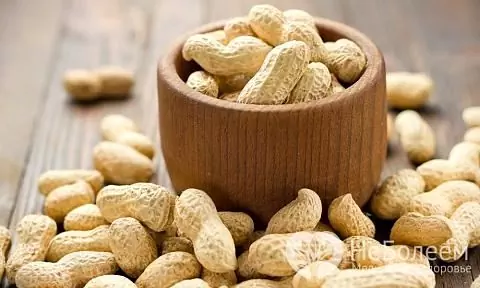- Author Rachel Wainwright [email protected].
- Public 2023-12-15 07:39.
- Last modified 2025-11-02 20:14.
Peanut poisoning
Despite popular belief and the characteristic name, peanuts are not a nut. It is a herbaceous annual plant of the legume family. Peanut shoots are branched, with an average height of 30-40 cm; one plant can ripen up to 40 beans.

Source: depositphotos.com
The name "peanut" peanuts received for the specificity of growth and maturation. The ovary, formed after the fertilization of the flower, gradually tilts towards the ground, eventually sinking into it. Ripening of peanut fruits, shaped like a cocoon, occurs in the soil, at a depth of 5 cm. Under the shell of one fruit there are up to 4-5 beans. When harvesting, the bushes are removed from the soil by the roots and turned over to avoid rotting during storage.
Peanuts have high nutritional characteristics and a wide range of beneficial properties:
- contains a large amount of antioxidants that protect body cells from the damaging effects of free radicals;
- reduces the likelihood of developing cardiovascular diseases, lowering the level of cholesterol in the blood and preventing the deposition of atherosclerotic plaques on the walls of blood vessels;
- helps to reduce the risk of developing certain forms of cancer;
- saturated with vitamins of groups B and E.
However, peanuts can be dangerous. Often it provokes allergic reactions, sometimes severe and lightning-fast. In young children, peanuts can cause digestive upset. Eating improperly stored peanuts leads to food poisoning.
How does peanut poisoning happen?
If the storage requirements are violated, the surface of the beans is colonized by molds that produce aflatoxins. This poison is one of the most dangerous for liver tissue, has a pronounced hepatotoxic effect. With a single intake of beans affected by molds, food poisoning develops.
When even a benign peanut is eaten by young children, digestive disorders develop, accompanied by general intoxication of the body. This effect is associated with the imperfection of the child's enzyme system, which is not able to ensure adequate digestion and assimilation of the components of peanuts, which are rich in proteins and fats.
Poisoning symptoms
Signs of peanut poisoning:
- nausea, vomiting;
- repeated loose stools;
- pain in the stomach and around the navel;
- belching, heartburn.
In addition to dyspeptic disorders, the victim is disturbed by the manifestations of general intoxication: headache, dizziness, severe weakness, feeling of weakness, drowsiness, fever, lack of appetite.
The duration of poisoning, depending on the severity, varies from 1-2 to 3-4 days. In children, the poisoning is more severe, the development of life-threatening conditions is possible due to severe dehydration and intense fever.

Source: depositphotos.com
First aid for peanut poisoning
- Gastric lavage (this requires drinking a large amount of warm water (1-1.5 liters) and provoking vomiting by pressing on the root of the tongue).
- Oral rehydration, or drinking, saline solutions (Hydrovit, Rehydron) and salt-free (rice water, tea, rosehip decoction): a tablespoon of liquid every few minutes, on average up to one and a half liters per hour in small sips for an adult. The volume of liquid for drinking a child with intense diarrhea: up to 2 years old - 50-100 ml after each bowel movement, over 2 years old - 100-200 ml. To prevent vomiting, it is necessary to water the child for 1-2 tsp. every 5-10 minutes.
- The use of enterosorbents for binding toxin and its elimination (Polysorb MP, Activated Carbon, Polyphepan, Enterosgel).
- Taking saline laxatives (magnesium sulfate).
When is medical attention required?
Qualified help is required in case of severe prolonged poisoning, when first aid measures do not have the desired effect or a deterioration in the condition is observed (increased pain, increased stool frequency, indomitable vomiting, persistent fever).
If a child is injured, it is imperative to see a doctor because of the high likelihood of complications.
Possible consequences
Complications of peanut poisoning develop, as a rule, in children:
- dehydration;
- reactive inflammation of the pancreas;
- convulsive syndrome at the height of fever;
- lesions of the central nervous system;
- damage to the kidneys, liver.
If you systematically consume peanuts contaminated with mold, aflatoxins accumulate in the body, causing cirrhosis and provoking malignant neoplasms of the liver.
Prevention
There are a number of mandatory rules for storing peanuts:
- tightly closed enamel or glassware;
- term - no more than 9 months in shell and 6 months in peeled form;
- dry, cool, ventilated place, optimal - refrigerator or freezer.
To prevent peanut poisoning, you must:
- comply with storage standards;
- do not eat beans that have traces of mold;
- do not eat clean beans from a common container, where there are moldy ones (washing, frying, drying is prohibited);
- do not allow children under 3 years old to eat peanuts;
- carefully check the shelf life and tightness of the packaged beans.
YouTube video related to the article:

Olesya Smolnyakova Therapy, clinical pharmacology and pharmacotherapy About the author
Education: higher, 2004 (GOU VPO "Kursk State Medical University"), specialty "General Medicine", qualification "Doctor". 2008-2012 - Postgraduate student of the Department of Clinical Pharmacology, KSMU, Candidate of Medical Sciences (2013, specialty "Pharmacology, Clinical Pharmacology"). 2014-2015 - professional retraining, specialty "Management in education", FSBEI HPE "KSU".
The information is generalized and provided for informational purposes only. At the first sign of illness, see your doctor. Self-medication is hazardous to health!






